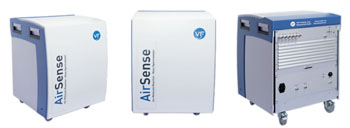Simple Breath Test Aids Type 1 Diabetes Early Diagnosis
By LabMedica International staff writers
Posted on 09 Dec 2014
A chemical marker has been identified for type 1 diabetes in the breath of children who are unaware they have the condition until they develop diabetic ketoacidosis, a potentially life-threatening complication and a breath test could pave the way to allow early diagnosis.Posted on 09 Dec 2014
The symptoms of the diabetes mellitus type 1, which include increased thirst and urination, fatigue and weight loss, can be mistaken for symptoms of other disorders and some cases where type 1 diabetes is misdiagnosed in children. A recent study found that between 2001 and 2009, incidence of type 1 diabetes among children aged less than 9 years rose by 21%.

Image: The AirSense is a mass spectrometer based on the patented Ion-Molecule Reaction (IMR-MS) and can be used for a broad field of applications (Photo courtesy of V&F).
Biochemists at the University of Oxford (UK) collected breath samples from 113 children and adolescents aged 7 to 18 years that had been diagnosed with type 1 diabetes. The team measured levels of acetone and another ketone called isoprene in the participants' breath and compared them with ketone and glucose levels in the blood, measurements of which were taken at the same time as breath samples were collected.
The patients blew through a tube and a bacterial filter into a specially constructed 100 mL syringe which had the aim of ensuring that the gases collected were end tidal. The sealed bags were analyzed by means of a soft-ionization mass spectrometer (V & F Airsense; Absam, Austria). Acetone, isoprene and carbon dioxide concentrations were measured, with the instrument standardized for its sensitivity to these compounds by using previously calibrated gas samples. Each patient provided blood for an HbA1c measurement and had capillary blood glucose and β hydroxybutyrate (BHB) levels measured using a FreeStyle Optium meter (Abbott, Maidenhead, UK).
The investigators found increased levels of acetone in the breath of the participants who also had increased levels of a ketone called β hydroxybutyrate in their blood. The team found a weak association between increased breath acetone and increased blood glucose but concluded that single breath measurements of acetone do not provide a good measure of blood glucose levels in this cohort. The team has already produced a prototype of a small hand-held device to measure ketone levels in the breath, which is currently being tested in clinical trials.
Gus Hancock, PhD, a professor of chemistry and a senior author of the study said, “Our results have shown that it is realistically possible to use measurements of breath acetone to estimate blood ketones. If the relationship between breath acetone and blood ketone levels is true at higher levels of ketones, a simple breath test could assist with the management of sick days in children with diabetes, preventing hospital admissions by providing a warning of the possible development of diabetic ketoacidosis (DKA).” The study was published on November 25, 2014, in the Journal of Breath Research.
Related Links:
University of Oxford
V & F Airsense
Abbott













